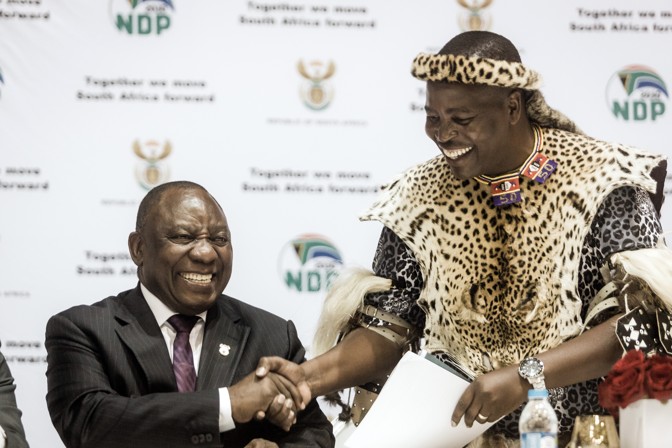BERLIN—Ahead of this month’s European Parliament elections, the far-right populist Alternative for Germany (AfD) party has been advocating leaving the euro zone and even, potentially, the European Union entirely.
A few years ago, the party membership’s decision to include a so-called Dexit in its 2019 platform—dependent, they say, on whether or not the EU accedes to its demands for significant reforms, including dissolving the European Parliament—would hardly have been notable. After all, the AfD was founded in 2013 as an anti-euro movement, and its counterparts across Europe rose to new electoral heights in part by portraying themselves as the bloc’s chief foes.
But among today’s far-right populist parties, that part of the AfD’s platform is more an exception than the rule. Leaders such as Marine Le Pen, of France’s National Rally, and Matteo Salvini, of Italy’s League, keen to consolidate right-wing support domestically and be taken more seriously internationally, have changed their tune when it comes to the EU. Instead of talking about referendums on EU membership or ditching Europe’s common currency, they advocate for a “Europe of nations” and more pragmatic change “from within.” Even the AfD’s top leaders seem to recognize that campaigning on Dexit isn’t as electorally helpful as it once was: The party now also talks about a “Europe of nations,” and co-leader Alexander Gauland has stressed that the AfD sees leaving the EU as a last resort and would prefer to “correct” it than “abolish” it.
The ultimate goal of the AfD and other parties, of course, remains the same: to return more decision-making power from the EU to the national level, particularly on policies related to refugees and migration. Were these parties to get their way, the EU would be gutted of all but its most basic duties—and after decades of greater integration and moves toward an “ever closer union,” the trajectory of Europe would turn back to having countries fend far more for themselves.
“None of them want to come across as crazy right-wing populists anymore—they all want to come across as serious politicians that represent the main right-wing party of their country,” Catherine Fieschi, the executive director of Counterpoint, a London-based think tank, told me. “They’ve all gone from deciding the best thing they could do is agitate and say outrageous stuff, to realizing … their best bet is actually to use [the EU] to make sure that they graduate to the next step, of legitimate politician.”
[Read: A new European political bloc wants to dismantle Europe]
Europe has had a difficult decade: Two major crises, one financial and one migration-related, have helped fuel euroskeptic rhetoric and given rise to parties that espouse it. After the 2008 financial crisis, the EU’s decision to bail out debt-ridden countries such as Greece helped bring about anti-euro movements. And when an influx of refugees arrived in Europe in 2015 and 2016, the resulting debate over who—if anyone—should take them in became the primary mobilizing issue for far-right parties.
Running as a euroskeptic in European Parliament elections seems, at first glance, a bit counterintuitive. If a party favors getting rid of EU structures entirely, why is it fielding candidates to serve in one of the bloc’s main institutions? When leaders of these groups have an answer to that question, they’ve suggested that as long as the EU exists, a seat at the table is better than being left standing on the outside. But contradictions aside, euroskeptic, far-right parties have typically performed well in European elections, benefiting from low turnout and a core base of energized supporters ready to air their grievances.
Still, the tide has changed since the last time these parties ran a European-level campaign—public support for the EU remains fairly high in many of their respective countries, and the ongoing Brexit saga makes replicating Britain’s path less palatable. In a Eurobarometer survey last fall, a record 68 percent of EU residents said that being part of the bloc has benefited their respective countries.
When Le Pen ran for president of France in 2017, opponents painted her as the potential destroyer of the EU. Anti-EU rhetoric, and especially her proposal to leave the euro zone, played a pivotal role in her campaign pitch. But after flopping in a televised debate when asked how her plan to ditch the euro would actually work, Le Pen paid the price at the polls, losing to now-President Emmanuel Macron by 32 points. After the election, she vowed to lead a “deep transformation” of her party and acknowledged that her strategy on Europe hadn’t helped. “We have heard the French people,” she said later that year. “In numerous areas it is possible to improve the daily life of the French without quitting Europe or the euro currency.”
[Read: How to discuss the far right without empowering it]
Italy’s Salvini has a similar story. After rising to the leadership of his far-right League in 2013, Salvini intensified the party’s rhetoric on both the euro and immigration. His strategy took the League from a struggling regional movement to a national force, earning 17 percent of the vote in last year’s Italian elections. Since entering into a governing coalition with the antiestablishment Five Star Movement last year, however, he’s taken a more pragmatic tack on Europe and talks today about “common sense” solutions and reforms, even as he blasts the bloc for its handling of migration policy. At his gathering of like-minded far-right parties in April, the tagline Towards a Common Sense Europe! appeared on a banner. “We don’t want to leave anything; we want to change the rules of the EU from the inside,” Salvini told Italian television in December.
In Austria, too, the far-right populist Freedom Party (FPÖ) had long been critical of the EU; some of its leaders even raised the possibility of a referendum for an “Oexit,” using the German name for Austria, Österreich, to build on the Brexit portmanteau. But when the FPÖ entered a governing coalition with Sebastian Kurz and his center-right People’s Party, in late 2017, Kurz took pains to make clear that the FPÖ had committed to a “pro-European” government. Standing alongside Kurz, the FPÖ’s leader, Heinz-Christian Strache, said at the time: “We stand by the European Union; we stand by Europe’s peace project.” (And earlier this year, the FPÖ’s top candidate in the European elections, Harald Vilimsky, said the party never actually wanted to leave the EU.)
The same transformation can be seen elsewhere. Jimmie Åkesson, the head of the right-wing populist Sweden Democrats, wrote in the Swedish newspaper Aftonbladet recently that his party was revising its stance on the EU. In order to truly be effective in today’s European political environment, Akesson wrote, one must “be pragmatic and fully utilize the opportunities that exist.”
How, precisely, these parties intend to actually reform Europe is typically not well explained. Apart from weakening the decision-making power of EU institutions and generally handing key functions back to individual nations, they have offered little in the way of concrete plans. Even among themselves, little agreement seems to exist, beyond the overall belief that Islam is a threat to what the parties perceive as a Christian Europe, and their desire to keep refugees and migrants out.
[Read: How the far right weaponized Europe’s interior ministries to block refugees]
“It’s mainly empty rhetoric; it’s really vague,” says Julian Göpffarth, a researcher at the London School of Economics who focuses primarily on the German far right. “I don’t think they have a real concept of what the EU would look like in the future.”
But these concerns will presumably only come to a head after this month’s vote is over. In the meantime, far-right leaders see a strong performance in the European Parliament elections as a key step toward being taken seriously as legitimate political players—and surely consider their toned-down EU rhetoric a way to realize that goal.
Jordan Bardella, the top candidate for Le Pen’s National Rally, put it this way in January: “There is this last step to reach—that of credibility, and we’re doing it.”














